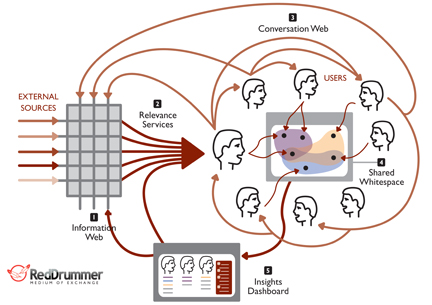An Economy of Insight Keynote in Internet Track |
||
 |
Five components |
|
extended abstract
Every day we open so many emails, respond to so many text messages and get so overwhelmed by the digital deluge, we wonder how we find time to do any work.
And we ourselves are to blame—we deploy technology that is optimized and commoditized according to an industrial-age model, namely, Shannon's "information theory". Just like a manufacturing assembly line, we break up knowledge work into small fragments and use our emails, texts, and social networks to exchange messages we already expect to receive. But this imprisons us in the past, because predictable messages can only tell us what we already know. Doing new things—innovating—means sharing messages we don't expect, with novel content and new ideas. Ironically, creating new ideas has become more expensive because of the burden of managing the deluge of messages we've made it so cheap to share.
We cannot solve this problem with the same technology that has caused it. To innovate, we need a new class of software grounded instead in "conversation theory", with a new economic unit of exchange: the insight. Our goal is to lower the cost of reaching insights—important ones, those that solve economic problems—and thereby create value. We envision a technology architecture that manages all the components of effective conversation—context, language, engagement, agreement, and coordinated transactions (C-L-E-A-T). This leads to new efficiencies in creating new business strategies, giving rise to a new marketplace while creating new sources of wealth. Call this new era "the conversation age", based on an economy of insight.
related media
acknowledgements
Thanks to André Vellozo, Global CEO, RedDrummer; and Walter Lee, RedDrummer US
biography
Paul Pangaro combines technical depth, marketing and business acumen, and passion for designing products and services that serve the cognitive and social needs of human beings. He has worked as CTO for startups such as Idealab's Snap.com, developed product roadmaps for consumer Internet companies, and managed developer outreach and web properties for Sun Microsystems, where he held the position of Senior Director / Distinguished Market Strategist and published a short book on transforming an existing business into new viability. From his background in the cybernetics of language, Paul has developed a methodology for modeling the conversations users need in order to understand how services can achieve their goals, and that brands need to convery value to and connect with their customers. He has collaborated closely with designers in creating high-traffic web sites and models of gnarly concepts such as innovation, play, and the creative process. From 2001 through 2007 he co-taught a course at Stanford University on the cybernetics of design. He has collaborated to create methologies for understanding and cultivating innovation strategies that he has presented in Brazil and Austria. Paul was awarded a BSci from MIT in Computer Science and Humanities, and a PhD from Brunel University, where Gordon Pask was his thesis advisor. He is currently founder and CTO of Cybernetic Lifestyles.com, a strategic marketing and product innovation consulting firm in New York City, with clients including Zite, Samsung, Nokia, Alcatel-Lucent, Instituto Itaú Cultural (São Paulo), Intellectual Ventures, Citigroup, Poetry Foundation, and Ogilvy & Mather. He serves on the board of Artship San Francisco, and is a Fellow andChair of the Trustees of the American Society for Cybernetics.
© Copyright Paul
Pangaro 2011.